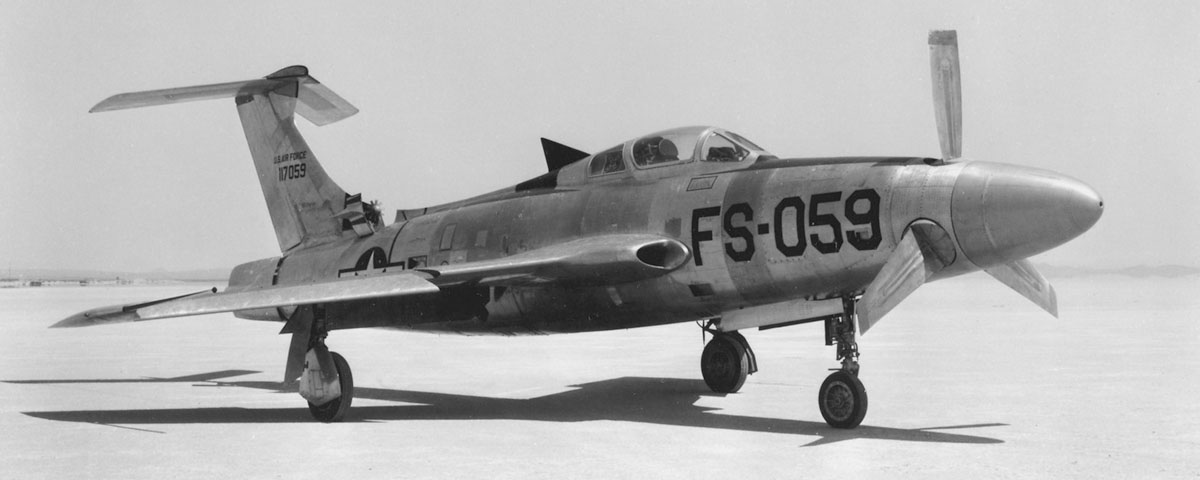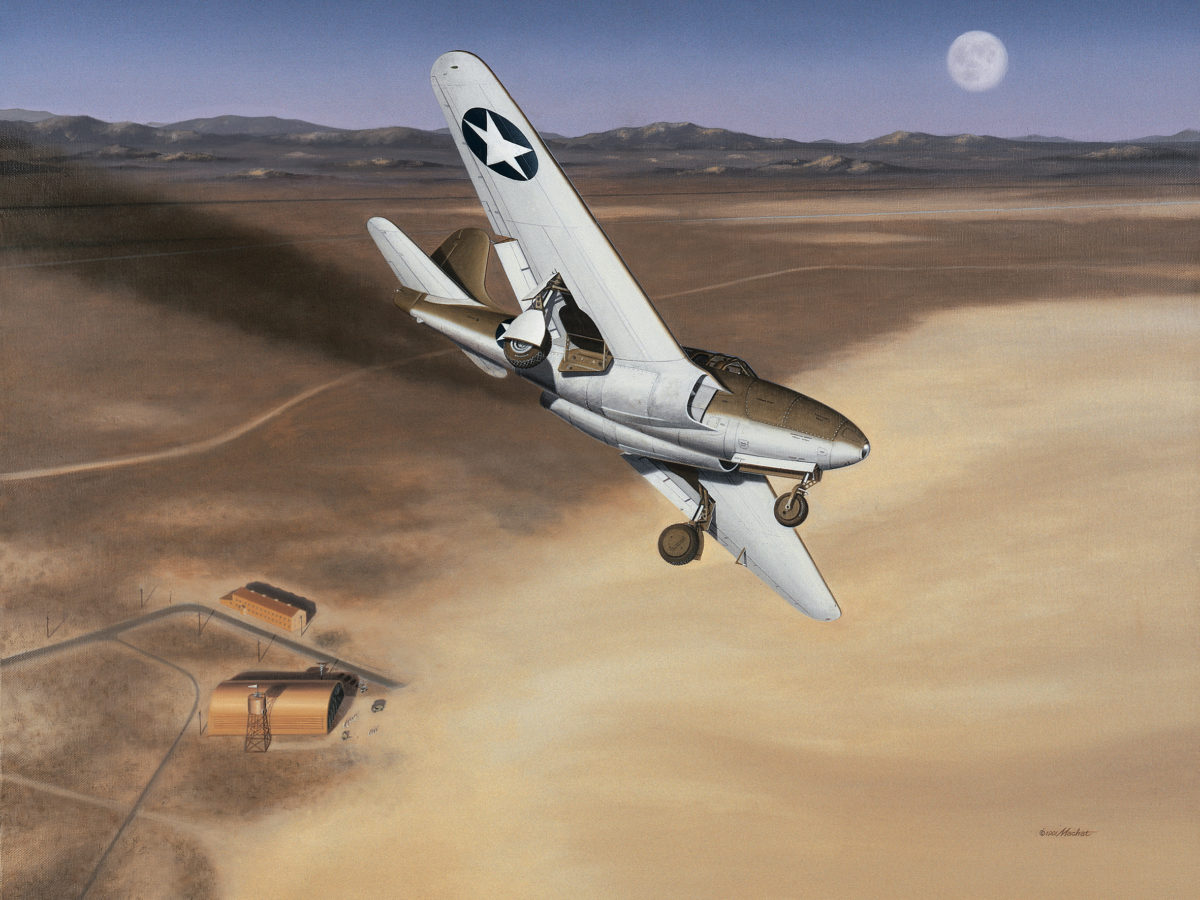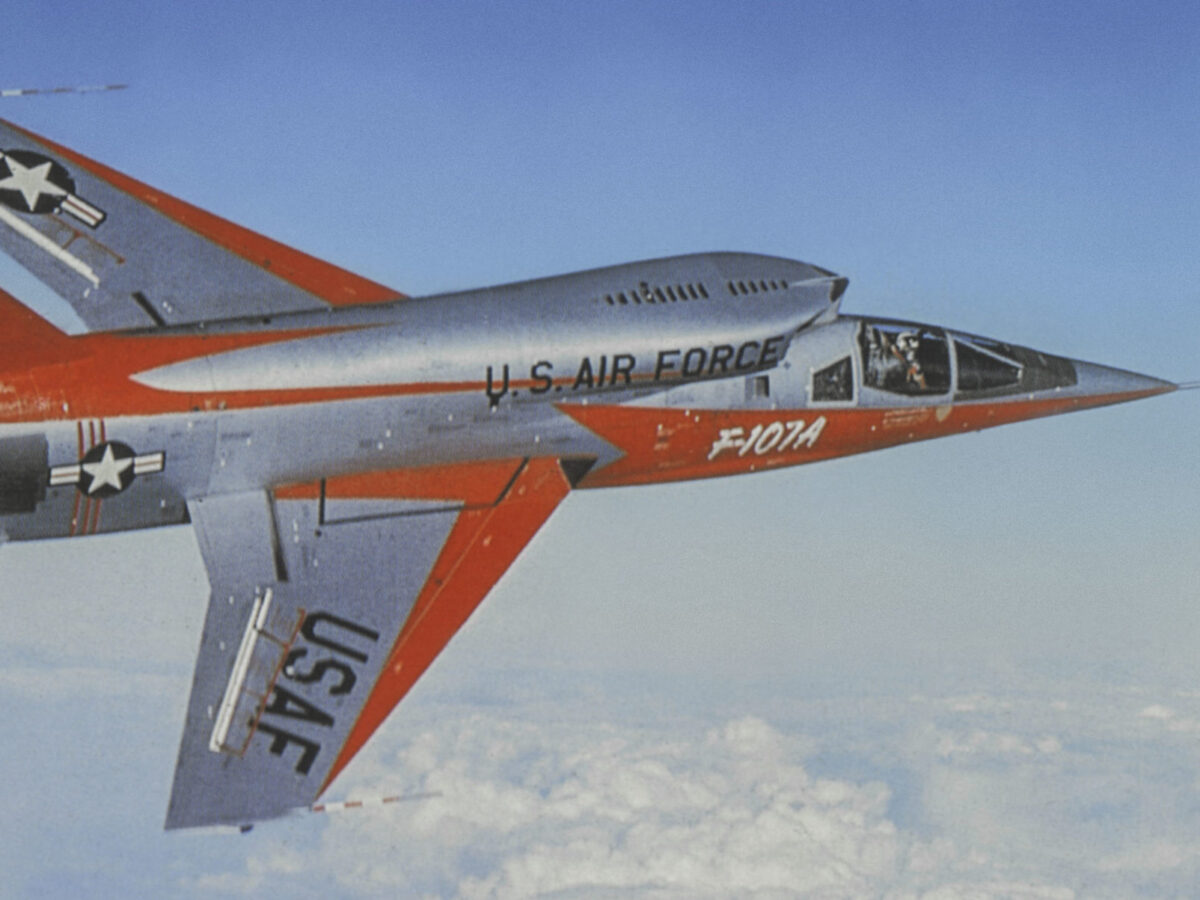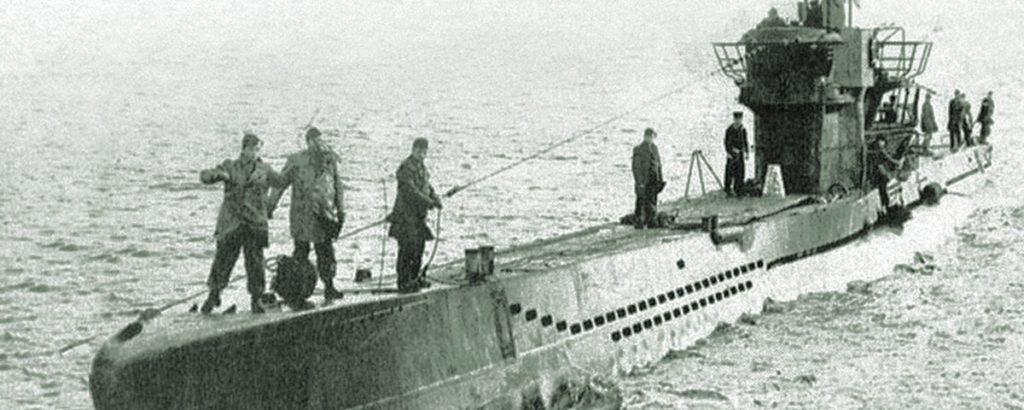Early jet fighters accelerated slowly and required long takeoff runs, and if a pilot needed to pour on the gas to correct a bad approach or make a go-around — particularly crucial for carrier aircraft — it was like trying to accelerate from 5 mph in a Porsche in top gear.
The Republic XF-84H Thunderscreech, developed in 1955, was an attempt to solve the problem by putting a stubby, high-speed propeller on a jet. The airplane’s nickname resulted from the fact that the prop tips went supersonic and stayed there as soon as the engine reached operating speed, making the XF-84H probably the loudest airplane ever built.
A QUICKER, MOre Fuel-Efficient Navy Jet
By June 1945, the U.S. Navy had begun to explore the turboprop, or propjet, as a solution to the performance problems associated with early jets. Essentially a gas turbine engine that drives a propeller, a turboprop operates at optimum rpm at all times, with power output controlled by adjusting the pitch, or angle of attack, of the propeller blades. The power from a turboprop is quicker and easier to control than that of a jet, and it also requires less fuel.
The Navy favored a gas turbine engine that Allison had begun developing in 1944 known as the T38, the initial version of which produced 2,250 shaft horsepower (shp) at 14,300 rpm, though a reduction gear ratio of 6.8-to-1 got the propeller rpm down to about 2,100 rpm. Even more attractive to the Navy was Allison’s double-turbine engine, known as the T40. Expected to produce as much as 7,500 shp, the T40 combined two T38 gas turbines mounted side by side and coupled to a single drive shaft via a common reduction gear. The T40 could drive contrarotating propellers that counteracted torque, making the aircraft easier to handle at low speeds. Cruising range could be greatly extended by shutting down one of the two turbines in flight and feathering its prop.
The Navy ordered a whole series of aircraft designed around the T40: two tail-sitting VTOL fighters, a twin-engine carrier-based bomber, a single-engine carrier-based strike aircraft and a four-engine flying boat. Of those, the two VTOL fighters (Convair XFY-1 Pogo and Lockheed XFV-1 Salmon) proved to be conceptually ill-conceived and never got beyond the prototype stage. The two carrier-based projects were turboprop developments of the piston-engine North American AJ Savage and Douglas AD Skyraider. In both cases, however, the T40 engines proved so unreliable that neither plane was acceptable. As a result, piston-engine Skyraiders were still flying combat missions over Vietnam nearly 20 years after the cancellation of their intended successor, the A2D Skyshark.
GET HISTORY’S GREATEST TALES—RIGHT IN YOUR INBOX
Subscribe to our HistoryNet Now! newsletter for the best of the past, delivered every Monday and Thursday.
‘A Monstrosity’
Even Allison’s official history, “Power of Excellence,” admitted that the T40 turboprop was “a monstrosity” and “a mechanical nightmare” that had been committed to production before it was ready. The main problems were in the reduction gears and propeller control systems, which simply weren’t strong enough. By the early 1950s, the Navy was rapidly losing interest in the T40.
At that point, however, the U.S. Air Force decided to use the T40 to see if it could develop an airplane that combined the supersonic speed of a jet with the acceleration of a prop-driven plane. Designed as a test-bed for supersonic airscrews at the Propeller Laboratory at Wright-Patterson Air Force Base, the XF-84H was built by Republic Aviation on the airframe of its successful F-84F Thunderstreak jet fighter.
The new plane was originally intended as a joint Air Force–Navy project, with one prototype to be built for the Navy and two for the Air Force. The Navy must have dropped out of the XF-84H program at an early stage, though, because only the two Air Force prototypes were constructed — nor does the aircraft seem to have ever received any analogous Navy designation.
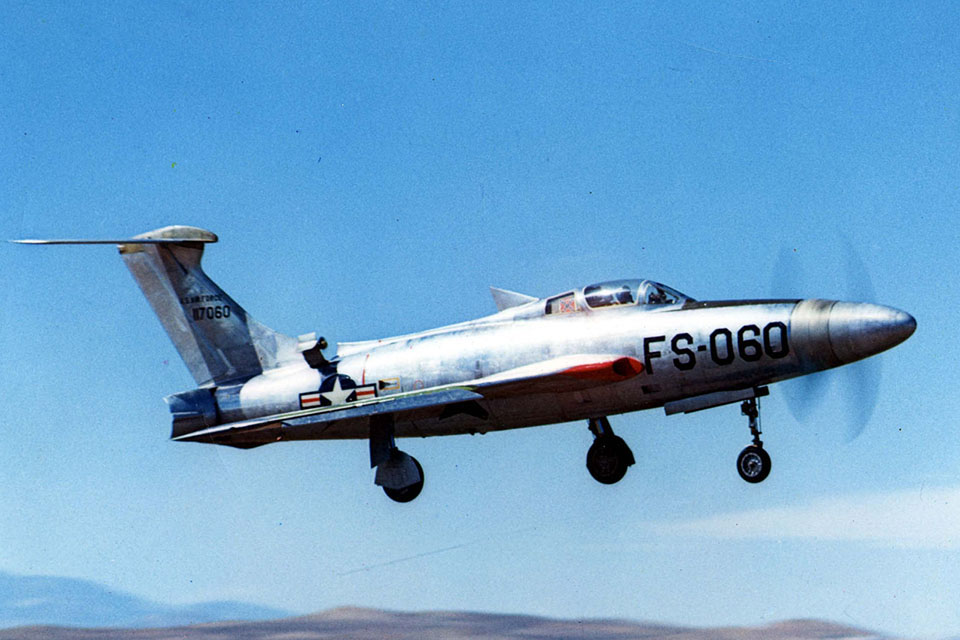
The Air Force contracted Aeroproducts, Curtiss-Wright and Hamilton Standard to produce a suitable high-performance prop. In the end, only Aeroproducts managed to come through, with an unusual 12-footdiameter, three-bladed airscrew with extraordinarily wide, square-tipped blades. The prop was designed to rotate at a constant 3,000 rpm, which meant that the outer 12 to 18 inches of the blades were supersonic, with the tips moving at Mach 1.18.
XF-84H vs. F-84F
The XF-84H bore a superficial resemblance to the F-84F Thunderstreak, although the two airframes actually shared few common components. The air intakes were relocated to the wing roots, as in the RF-84F Thunderflash photoreconnaissance version of the Republic fighter. Apart from the prop and a huge spinner added to its nose, the XF-84H’s fuselage had to be widened to accommodate the T40 twin-turbine engine, mounted behind the cockpit. A pair of lengthy extension shafts, supported by an array of bearings, passed by the cockpit to drive the single prop via a reduction gear. The powerful propeller generated so much turbulence that the horizontal tail surfaces had to be raised to a position on top of the tail fin to clear the propwash, and an additional vertical “shark fin” was installed behind the cockpit to improve stability.
The completed XF-84H differed so markedly from the production F-84 that at first the Air Force intended to designate it the F-106. In the end, however, the F-106 designation was reassigned to Convair’s supersonic delta-winged interceptor, popularly known as the Delta Dart.
The XF-84H incorporated many novel features, including a retractable ram-air turbine designed to deploy into the slipstream automatically whenever the landing gear was extended, to provide additional electrical and hydraulic power. It was the first aircraft so equipped—fortunate, considering that 11 out of its 12 test flights ended in engine failures.
The XF-84H was also the only turboprop to be outfitted with an afterburner. The T40 engine normally produced 5,850 hp, but the Air Force expected the afterburner to boost output to 7,400 hp, theoretically enabling the airplane to fly at supersonic speed if its prop was feathered. However, the test program was canceled before the afterburner was ever lit in flight.
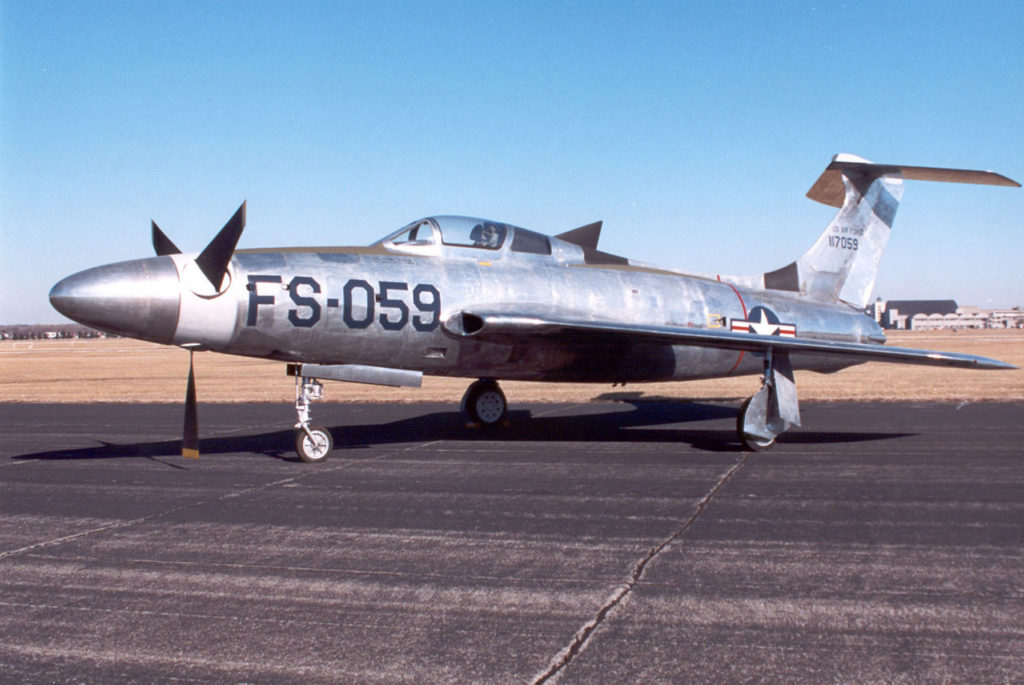
The XF-84H’s Many Problems
Recommended for you
Although continual engine, drive shaft and gearbox problems dogged the XF-84H prototypes, their most notable shortcoming was the ear-splitting howl produced by their supersonic propeller blades. Since the company’s previous aircraft had been named Thunderbolt, Thunderjet, Thunderstreak and Thunderflash, it was inevitable that the XF-84H soon became known, albeit unofficially, as the “Thunderscreech.” The howl of the Thunderscreech warming up its engine could reputedly be heard more than 20 miles away. The engine had to be test-run at a remote part of Edwards AFB because the noise prevented air traffic controllers from hearing anything over their radios.
Only two civilian test pilots ever flew the “Screech,” and one of them quit after just one flight, saying to the tackle-size Republic project engineer, “You aren’t big enough and there aren’t enough of you to get me in that thing again.”
The other, Hank Beaird, made 11 flights in the XF-84H — 10 of which ended in premature or emergency landings.
“It became a handful … when you got it out around 400 knots,” Beaird said. “The propeller governor would start surging, and the airplane would roll rather violently.” The entire airplane, in fact, was trying to torque itself around the propshaft, rotating left while the prop spun to the right.
“As long as you stood ahead or behind the airplane it really wasn’t so bad,” he said, “but if you got in the plane of the prop [the shockwaves] would knock you down.”
Small wonder the XF-84H earned yet another distinction — the only USAF prototype that was never flown by an Air Force pilot.
First flown on July 22, 1955, the XF-84H had excellent acceleration but soon demonstrated its impracticality. Since the engine took a full half hour to warm up, the airplane was clearly unsuited to combat. But the most serious problems stemmed from mechanical difficulties with the prop pitch gearing, as well as in-flight vibration generated by the 18-foot-long propeller shafts. The two planes logged a total flight time of less than 10 hours over a 15-month period.
Although Republic predicted the XF-84H was capable of 670 mph — which would have made it the fastest prop-driven aircraft ever built — it never actually exceeded 450 mph. The record belongs instead to the Tupolev Tu-95, code-named “Bear” by NATO. Powered by four 14,800-hp turboprops, the Tu-95 cruises at 545 mph and can reach 575 mph.
One of the two Thunderscreech prototypes long served as a gate guard at an airport in Bakersfield, California. In 1992 it was transferred to the National Museum of the U.S. Air Force, where it’s now on display.
Originally published in the November 2010 issue of Aviation History.
historynet magazines
Our 9 best-selling history titles feature in-depth storytelling and iconic imagery to engage and inform on the people, the wars, and the events that shaped America and the world.


